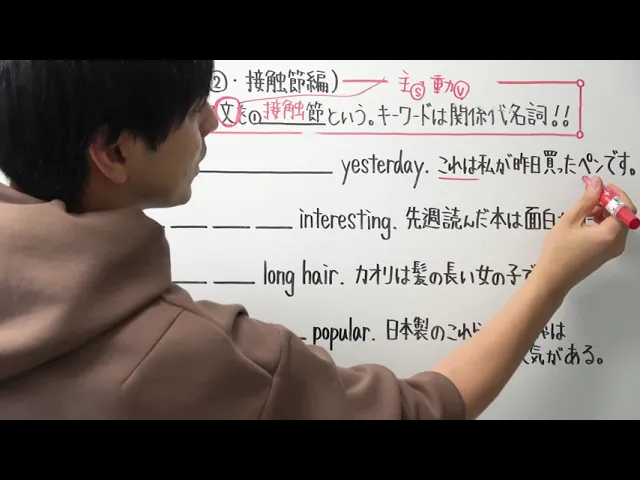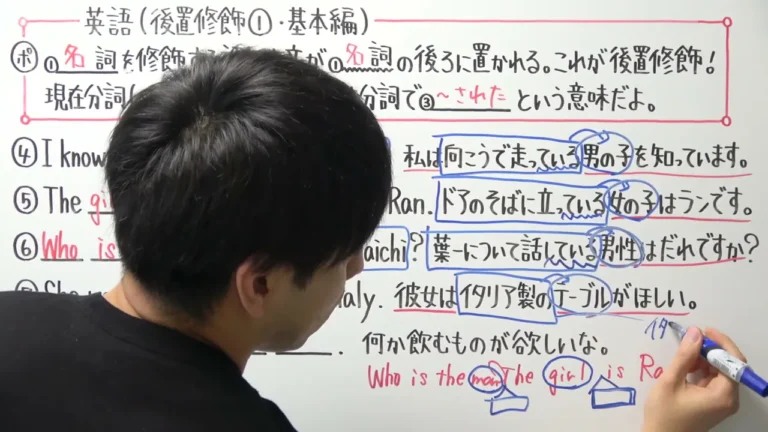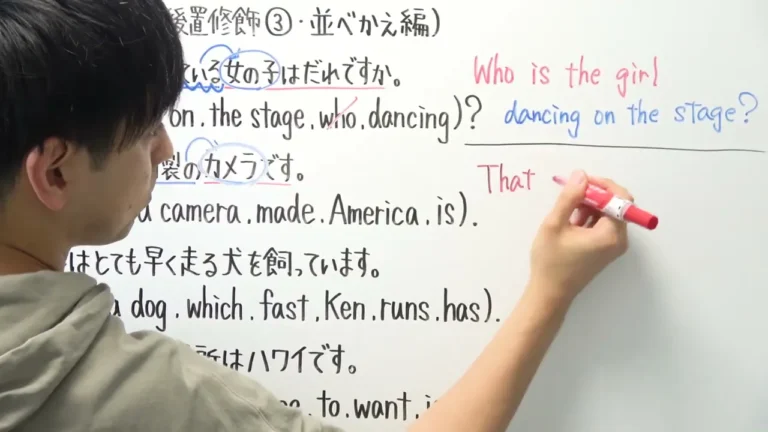後置修飾⓶
これらの質問は、レッスンで教えられたすべてのポイントをカバーし、Bloom’s Taxonomyの各レベルで知識、理解、応用、分析、評価、創造を促すように設計されています。
Bloom’s Taxonomy Comprehension Check Questions
Knowledge (知識)
- 接触節とはどのような文のことですか?
- What kind of×「What kind of」は「どのような」という意味です。 例文: What kind of music do you like? どのような音楽が好きですか? sentence is a contact clause×「a contact clause」は「接触節」という意味です。関係代名詞が省略された関係節のことです。 文法説明: - 関係代名詞(which, that, who, whom)が省略されている - 後置修飾として機能し、名詞を修飾する - 主語と動詞がある場合が多い 例文: The book I read yesterday was interesting. 私が昨日読んだ本は面白かった。 ※「I read yesterday」は接触節です (本来は'The book that I read yesterday...'となる) 注意点: - 日本語の感覚と異なり、関係詞を省略することが可能です - 接触節は、関係詞節の一種です - 目的格の関係代名詞が省略される場合に使われます?
- 接触節を構成する上で重要なキーワードは何ですか?
- What is the important keyword×「What is the important keyword」は「重要なキーワードは何ですか」という意味です。 例文: What is the important keyword in this sentence? この文で重要なキーワードは何ですか? when constructing×「constructing」は「構成する」という意味です。 例文: When constructing a building, you need a good plan. 建物を構成する際、良い計画が必要です。 a contact clause×「a contact clause」は「接触節」という意味です。関係代名詞が省略された関係節のことです。 文法説明: - 関係代名詞(which, that, who, whom)が省略されている - 後置修飾として機能し、名詞を修飾する - 主語と動詞がある場合が多い 例文: The book I read yesterday was interesting. 私が昨日読んだ本は面白かった。 ※「I read yesterday」は接触節です (本来は 'The book that I read yesterday...'となる) 注意点: - 日本語の感覚と異なり、関係詞を省略することが可能です - 接触節は、関係詞節の一種です - 目的格の関係代名詞が省略される場合に使われます?
- 関係代名詞の省略は必ずできますか?
- Is the omission×「omission」は「省略」という意味です。
例文:
The omission of details made the text unclear.
詳細の省略がテキストを不明瞭にしました。 of a relative pronoun×「a relative pronoun」は「関係代名詞」という意味です。先行詞を修飾する節を導く代名詞です (who, which, thatなど)。
文法説明:
- 関係代名詞は先行詞(名詞)と関係節を結びつける
- 主格、目的格、所有格がある
- 関係代名詞は省略できる場合がある
例文:
The book which I read yesterday was interesting.
私が昨日読んだ本は面白かった。
※「which」は関係代名詞です。
よくある間違い:
- 関係代名詞の種類を間違えないように注意
- 関係代名詞の省略は常に可能ではない
- 関係副詞と混同しないように注意 always possible×「always possible」は「常に可能」という意味です。
例文:
Is it always possible to get a refund?
常に払い戻しを受けることは可能ですか??
- Is the omission×「omission」は「省略」という意味です。
Comprehension (理解)
- 接触節が後置修飾として機能する仕組みを、自分の言葉で説明してください。
- Explain in your own words×「Explain in your own words」は「自分の言葉で説明する」という意味です。
例文:
Please explain it in your own words.
それを自分の言葉で説明してください。 how a contact clause×「how a contact clause」は「接触節がどのように」という意味です。
例文:
Explain how a contact clause works.
接触節がどのように機能するか説明してください。 functions as a post-modifier×「functions as a post-modifier」は「後置修飾として機能する」という意味です。
例文:
Explain how it functions as a post-modifier.
それが後置修飾としてどのように機能するか説明してください。.
- Explain in your own words×「Explain in your own words」は「自分の言葉で説明する」という意味です。
- なぜ関係代名詞の省略が可能な場合と不可能な場合があるのですか?
- Why are there cases where×「Why are there cases where」は「なぜ〜の場合があるのですか?」という意味です。
例文:
Why are there cases where the rules don't apply?
なぜその規則が適用されない場合があるのですか? relative pronouns×「relative pronouns」は「関係代名詞」の複数形です。先行詞を修飾する節を導く代名詞です (who, which, thatなど)。
例文:
Relative pronouns are important for joining sentences.
関係代名詞は文をつなぐために重要です。 can be omitted×「can be omitted」は「省略できる」という意味です。
例文:
In some cases, the article can be omitted.
場合によっては冠詞が省略できます。 and cases where they cannot be omitted×「they cannot be omitted」は「それらが省略できない」という意味です。
例文:
There are cases where they cannot be omitted.
それらが省略できない場合があります。?
- Why are there cases where×「Why are there cases where」は「なぜ〜の場合があるのですか?」という意味です。
- 接触節と関係代名詞を使った文の構造上の類似点を説明してください。
- Explain the structural similarities between×「Explain the structural similarities between」は「〜の構造上の類似点を説明する」という意味です。
例文:
Explain the structural similarities between these two buildings.
この二つの建物の構造上の類似点を説明してください。 sentences using a contact clause×「sentences using a contact clause」は「接触節を使った文」という意味です。
例文:
He explained sentences using a contact clause.
彼は接触節を使った文を説明した。 and sentences using a relative pronoun×「sentences using a relative pronoun」は「関係代名詞を使った文」という意味です。
例文:
Compare sentences using a relative pronoun and sentences without it.
関係代名詞を使った文と使わない文を比較してください。.
- Explain the structural similarities between×「Explain the structural similarities between」は「〜の構造上の類似点を説明する」という意味です。
Application (応用)
- 「私が昨日読んだ本は面白かった」という文を、接触節を使って英語で完成させてください。
- Complete the sentence×「Complete the sentence」は「文を完成させる」という意味です。
例文:
Complete the sentence with the right words.
正しい単語で文を完成させてください。 in English using a contact clause×「using a contact clause」は「接触節を使って」という意味です。関係代名詞が省略された関係節を使って文を完成させることを指します。
例文:
Write the sentence using a contact clause.
接触節を使って文を書いてください。.
- Complete the sentence×「Complete the sentence」は「文を完成させる」という意味です。
- 「私が描いた絵はとても綺麗だ」という文を、接触節を使って英語にしてください。
- Translate the sentence into English×「Translate the sentence into English」は「文を英語に翻訳する」という意味です。
例文:
Can you translate this sentence into English?
この文を英語に翻訳できますか? using a contact clause×「using a contact clause」は「接触節を使って」という意味です。関係代名詞が省略された関係節を使って文を翻訳することを指します。
例文:
Translate the sentence using a contact clause.
接触節を使ってその文を翻訳してください。. - 以下の日本語の語句を英訳しなさい。
- Translate the following Japanese phrases×「Translate the following Japanese phrases」は「以下の日本語の語句を翻訳する」という意味です。
例文:
Translate the following Japanese phrases into English.
以下の日本語の語句を英語に翻訳してください。 into English: - 私が買ったペン
- 私が先週読んだ本
- Translate the following Japanese phrases×「Translate the following Japanese phrases」は「以下の日本語の語句を翻訳する」という意味です。
Analysis (分析)
- 接触節を使用する事によって、文がどのように変化し、より複雑な情報を伝達できるようになりますか?
- How does the use of×「How does the use of」は「〜の使用はどのように」という意味です。
例文:
How does the use of this technology change our lives?
この技術の使用はどのように私たちの生活を変えるのでしょうか? contact clauses×「contact clauses」は「接触節」の複数形です。関係代名詞が省略された関係節を指します。
例文:
Contact clauses are often used in spoken English.
接触節は日常会話でよく使われます。 change the sentence×「change the sentence」は「文を変える」という意味です。
例文:
How does the use of passive voice change the sentence?
受動態の使用はどのように文を変えるのでしょうか? and make it possible×「make it possible」は「〜を可能にする」という意味です。
例文:
Technology makes it possible to learn new things easily.
テクノロジーは新しいことを簡単に学ぶことを可能にします。 to convey×「convey」は「伝える」という意味です。
例文:
How can we convey this information clearly?
この情報をどうすれば明確に伝えることができるでしょうか? more complex information×「complex information」は「複雑な情報」という意味です。
例文:
Complex information requires clear communication.
複雑な情報には明確なコミュニケーションが必要です。?
- How does the use of×「How does the use of」は「〜の使用はどのように」という意味です。
- このレッスンで取り扱った接触節が、関係代名詞の省略によってどのように生じるか分析してください。
- Analyze how×「Analyze how」は「どのように分析する」という意味です。
例文:
Analyze how this process is done.
このプロセスがどのように行われるか分析してください。 the contact clause×「contact clause」は「接触節」という意味です。関係代名詞が省略された関係節のことです。
例文:
A contact clause can often make sentences more concise.
接触節は文をより簡潔にすることがよくあります。 discussed in this lesson×「discussed in this lesson」は「このレッスンで議論された」という意味です。
例文:
The grammar points discussed in this lesson are important.
このレッスンで議論された文法事項は重要です。 arises from×「arises from」は「〜から生じる」という意味です。
例文:
His inspiration arises from his daily experiences.
彼のインスピレーションは彼の日常経験から生じます。 the omission of×「the omission of」は「〜の省略」という意味です。
例文:
The omission of key details can cause misunderstandings.
重要な詳細の省略は誤解を引き起こす可能性があります。 relative pronouns×「relative pronouns」は「関係代名詞」の複数形です。先行詞を修飾する節を導く代名詞です (who, which, thatなど)。
例文:
Relative pronouns are used to connect clauses.
関係代名詞は節をつなぐために使われます。.
- Analyze how×「Analyze how」は「どのように分析する」という意味です。
- 接触節と、前回の動画で学んだ現在分詞や過去分詞を使った後置修飾を、それぞれどのように使い分けるべきか分析してください。
- Analyze how to choose between×「Analyze how to choose between」は「〜の使い分け方を分析する」という意味です。
例文:
Analyze how to choose between these options.
これらの選択肢の使い分け方を分析してください。 contact clauses×「contact clauses」は「接触節」の複数形です。関係代名詞が省略された関係節を指します。
例文:
Contact clauses are often used in informal writing.
接触節はしばしばインフォーマルな文章で使われます。 and the present or past participles×「present or past participles」は「現在分詞または過去分詞」という意味です。
例文:
Present or past participles can modify nouns.
現在分詞または過去分詞は名詞を修飾することができます。 taught in the previous video×「taught in the previous video」は「前の動画で教えられた」という意味です。
例文:
This concept was taught in the previous video.
この概念は前の動画で教えられました。 for use in post-modification×「post-modification」は「後置修飾」という意味です。名詞を後ろから修飾する語句や節を指します。
例文:
Post-modification is common in English.
後置修飾は英語で一般的です。.
- Analyze how to choose between×「Analyze how to choose between」は「〜の使い分け方を分析する」という意味です。
Evaluation (評価)
- 接触節を理解することは、英語の文章理解においてどのようなメリットがありますか?
- What are the benefits of×「What are the benefits of」は「〜のメリットは何ですか?」という意味です。
例文:
What are the benefits of learning a new language?
新しい言語を学ぶメリットは何ですか? understanding contact clauses×「understanding contact clauses」は「接触節を理解すること」という意味です。
例文:
Understanding contact clauses can improve reading skills.
接触節を理解することは読解力を向上させることができます。 in terms of×「in terms of」は「〜の観点から」という意味です。
例文:
In terms of cost, it is a good deal.
コストの観点からすると、それは良い取引です。 understanding English sentences?
- What are the benefits of×「What are the benefits of」は「〜のメリットは何ですか?」という意味です。
- 今回学んだ接触節のルールを基に、自分で文を作り、その文が正しく後置修飾されているか評価してください。
- Based on the rules of×「Based on the rules of」は「〜のルールに基づいて」という意味です。
例文:
Based on the rules of grammar, this sentence is correct.
文法のルールに基づくと、この文は正しいです。 contact clauses×「contact clauses」は「接触節」の複数形です。関係代名詞が省略された関係節を指します。
例文:
Contact clauses can be difficult for non-native speakers.
接触節はネイティブスピーカーでない人にとって難しい場合があります。 you learned, create your own sentence×「create your own sentence」は「自分で文を作る」という意味です。
例文:
Create your own sentence using the new vocabulary.
新しい語彙を使って自分で文を作ってください。 and evaluate whether×「evaluate whether」は「〜かどうかを評価する」という意味です。
例文:
Evaluate whether this plan is feasible.
この計画が実現可能かどうか評価してください。 it uses post-modification correctly×「it uses post-modification correctly」は「それが後置修飾を正しく使っているか」という意味です。
例文:
Evaluate whether it uses post-modification correctly.
それが後置修飾を正しく使っているか評価してください。.
- Based on the rules of×「Based on the rules of」は「〜のルールに基づいて」という意味です。
- 今回学んだ接触節を、今後どのような場面で活用できると思いますか?
- In what situations do you think you will be able to×「In what situations do you think you will be able to」は「どのような状況で〜することができると思いますか?」という意味です。
例文:
In what situations do you think you will be able to use this skill?
どのような状況でこのスキルを使うことができると思いますか? use the contact clauses×「contact clauses」は「接触節」の複数形です。関係代名詞が省略された関係節を指します。
例文:
Contact clauses are common in academic writing.
接触節は学術的な文章でよく使われます。 you learned in the future×「in the future」は「今後」という意味です。
例文:
What are your plans in the future?
あなたの今後の計画は何ですか??
- In what situations do you think you will be able to×「In what situations do you think you will be able to」は「どのような状況で〜することができると思いますか?」という意味です。
Creation (創造)
- あなたが一番好きな本を説明する文を、接触節を使って作ってください。
- Create a sentence using×「Create a sentence using」は「〜を使って文を作る」という意味です。
例文:
Create a sentence using this new word.
この新しい単語を使って文を作ってください。 a contact clause×「a contact clause」は「接触節」という意味です。関係代名詞が省略された関係節のことです。
例文:
Write a sentence using a contact clause.
接触節を使って文を書いてください。 to describe your favorite book×「describe your favorite book」は「あなたの一番好きな本を説明する」という意味です。
例文:
Describe your favorite book.
あなたの一番好きな本を説明してください。.
- Create a sentence using×「Create a sentence using」は「〜を使って文を作る」という意味です。
- 接触節を使った後置修飾の文を3つ自分で作り、その文の意味を説明してください。
- Create three sentences×「Create three sentences」は「3つの文を作る」という意味です。
例文:
Create three sentences to show you understand.
あなたが理解していることを示すために3つの文を作ってください。 using contact clauses×「contact clauses」は「接触節」の複数形です。関係代名詞が省略された関係節を指します。
例文:
Contact clauses make your writing sound more natural.
接触節はあなたの文章をより自然に聞こえさせます。 for post-modification×「post-modification」は「後置修飾」という意味です。名詞を後ろから修飾する語句や節を指します。
例文:
Post-modification is often used in complex sentences.
後置修飾は複雑な文でよく使われます。 and explain what they mean×「explain what they mean」は「それらが何を意味するか説明する」という意味です。
例文:
Write the sentences and explain what they mean.
文を書いて、それらが何を意味するか説明してください。.
- Create three sentences×「Create three sentences」は「3つの文を作る」という意味です。
- 今回学んだことを踏まえ、接触節の理解を深めるための新たな学習方法を提案してください。
- Based on what you have learned×「Based on what you have learned」は「あなたが学んだことに基づいて」という意味です。
例文:
Based on what you have learned, what do you think?
あなたが学んだことに基づいて、どう思いますか?, propose a new study method×「propose a new study method」は「新しい学習方法を提案する」という意味です。
例文:
Propose a new study method to learn faster.
より速く学習するための新しい学習方法を提案してください。 to deepen your understanding×「deepen your understanding」は「理解を深める」という意味です。
例文:
Study more to deepen your understanding.
理解を深めるためにもっと勉強してください。 of contact clauses×「contact clauses」は「接触節」の複数形です。関係代名詞が省略された関係節を指します。
例文:
Practice is the key to understanding contact clauses.
練習は接触節を理解するための鍵です。.
- Based on what you have learned×「Based on what you have learned」は「あなたが学んだことに基づいて」という意味です。


